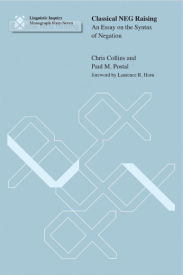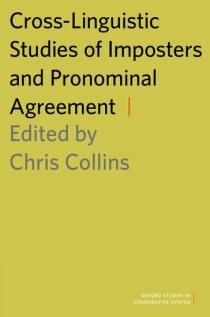Books by Chris Collins on Amazon.com
2020
Smuggling in Syntax. Oxford University Press. (Co-edited with Adriana Belletti)
 Smuggling in Syntax investigates how different movement operations interact with one another, focussing on the special case of smuggling. First introduced by volume editor Chris Collins in 2005, the term ‘smuggling’ refers to a specific type of movement interaction. The contributions in this volume each describe different areas where smuggling derivations play a role, including passives, causatives, adverb placement, the dative alternation, the placement of measure phrases, wh-in-situ, and word order in ergative languages. The volume also addresses issues like the freezing constraint on movement and the acquisition of smuggling derivations by children.
Smuggling in Syntax investigates how different movement operations interact with one another, focussing on the special case of smuggling. First introduced by volume editor Chris Collins in 2005, the term ‘smuggling’ refers to a specific type of movement interaction. The contributions in this volume each describe different areas where smuggling derivations play a role, including passives, causatives, adverb placement, the dative alternation, the placement of measure phrases, wh-in-situ, and word order in ergative languages. The volume also addresses issues like the freezing constraint on movement and the acquisition of smuggling derivations by children.
2019
The Linker in the Khoisan Languages. Oxford University Press.
 The linker introduces (“links”) a variety of expressions into the verb phrase, including locatives, the second object of a double object construction, the second object of a causative, instruments, subject matter arguments, and adverbs. This volume collects together Chris Collins’s published work on the linker in the Khoisan languages. Here, Collins offers a systematic description of the linker in ǂHoã, Juǀ’hoan, Nǀuu, and to a lesser extent ǃXoõ and ǀXam. For each language, Collins illustrates various uses of the linker, drawing attention to cross-linguistic generalizations as well as to variation between the languages. The work presented in this volume should be of interest to researchers working in a wide variety of syntactic frameworks on different languages of the world.
The linker introduces (“links”) a variety of expressions into the verb phrase, including locatives, the second object of a double object construction, the second object of a causative, instruments, subject matter arguments, and adverbs. This volume collects together Chris Collins’s published work on the linker in the Khoisan languages. Here, Collins offers a systematic description of the linker in ǂHoã, Juǀ’hoan, Nǀuu, and to a lesser extent ǃXoõ and ǀXam. For each language, Collins illustrates various uses of the linker, drawing attention to cross-linguistic generalizations as well as to variation between the languages. The work presented in this volume should be of interest to researchers working in a wide variety of syntactic frameworks on different languages of the world.
2014
A Grammar of ǂHȍã. Rüdiger Köppe Verlag. (Co-authored with Jeffrey Gruber)
 ǂHȍã is a (non-central) Khoisan language spoken south of the Khutse game reserve in Botswana. Some of the places where speakers can be found today are (from west to east): Khekhenye, Tshwaane, Dutlwe, Salajwe and Shorilatholo (and nearby cattle posts). It is closely related to Sàsí, whose speakers are found in eastern Botswana in Bodungwane, Dibete, Mokgenene, Poloka and Lethajwe (and nearby cattle posts). We group ǂHȍã and Sàsí into a group we call #’Amkoe (meaning “person” in both languages). In this grammar, we focus on ǂHȍã, but we occasionally give comparisons to Sàsí where we have the relevant data.
ǂHȍã is a (non-central) Khoisan language spoken south of the Khutse game reserve in Botswana. Some of the places where speakers can be found today are (from west to east): Khekhenye, Tshwaane, Dutlwe, Salajwe and Shorilatholo (and nearby cattle posts). It is closely related to Sàsí, whose speakers are found in eastern Botswana in Bodungwane, Dibete, Mokgenene, Poloka and Lethajwe (and nearby cattle posts). We group ǂHȍã and Sàsí into a group we call #’Amkoe (meaning “person” in both languages). In this grammar, we focus on ǂHȍã, but we occasionally give comparisons to Sàsí where we have the relevant data.
Classical NEG Raising: An Essay on the Syntax of Negation. MIT Press, Cambridge, MA. (Co-authored with Paul Postal)
 In this book, Chris Collins and Paul Postal consider examples such the one below on the interpretation where Nancy thinks that this course is not interesting:
In this book, Chris Collins and Paul Postal consider examples such the one below on the interpretation where Nancy thinks that this course is not interesting:
Nancy doesn’t think this course is interesting.
They argue such examples instantiate a kind of syntactic raising that they term Classical NEG Raising. This involves the raising of a NEG (negation) from the embedded clause to the matrix clause. Collins and Postal develop three main arguments to support their claim. First, they show that Classical NEG Raising obeys island constraints. Second, they document that a syntactic raising analysis predicts both the grammaticality and particular properties of what they term Horn clauses (named for Laurence Horn, who discovered them). Finally, they argue that the properties of certain parenthetical structures strongly support the syntactic character of Classical NEG Raising.
Cross-Linguistic Studies of Imposters and Pronominal Agreement. (ed.)
 This volume explores verbal and pronominal agreement with imposters from a cross-linguistic perspective. The central questions for any given language are: (a) How do singular and plural imposters agree with the verb? (b) When a pronoun has an imposter antecedent, what are the phi-features of the pronoun? The volume reveals a remarkable degree of variation in the answers to these questions, but also reveals some underlying generalizations. The contributions describe imposters in Bangla, Spanish, Albanian, Indonesian, Italian, French, Romanian, Mandarin and Icelandic.
This volume explores verbal and pronominal agreement with imposters from a cross-linguistic perspective. The central questions for any given language are: (a) How do singular and plural imposters agree with the verb? (b) When a pronoun has an imposter antecedent, what are the phi-features of the pronoun? The volume reveals a remarkable degree of variation in the answers to these questions, but also reveals some underlying generalizations. The contributions describe imposters in Bangla, Spanish, Albanian, Indonesian, Italian, French, Romanian, Mandarin and Icelandic.
2012
Imposters. MIT Press, Cambridge, MA. (Co-authored with Paul Postal)
 Normally, a speaker uses a first person singular pronoun (in English, I, me, mine, myself) to refer to himself or herself. To refer to a single addressee, a speaker uses second person pronouns (you, yours, yourself). But sometimes third person nonpronominal DPs are used to refer to the speaker—for example, this reporter, yours truly—or to the addressee—my lord, the baroness, Madam (Is Madam not feeling well?). Chris Collins and Paul Postal refer to these DPs as imposters because their third person exterior hides a first or second person core.
Normally, a speaker uses a first person singular pronoun (in English, I, me, mine, myself) to refer to himself or herself. To refer to a single addressee, a speaker uses second person pronouns (you, yours, yourself). But sometimes third person nonpronominal DPs are used to refer to the speaker—for example, this reporter, yours truly—or to the addressee—my lord, the baroness, Madam (Is Madam not feeling well?). Chris Collins and Paul Postal refer to these DPs as imposters because their third person exterior hides a first or second person core.
In this book they study the interactions of imposters with a range of grammatical phenomena, including pronominal agreement, coordinate structures, Principle C phenomena, epithets, fake indexicals, and a property of pronominal agreement they call homogeneity.
2011
A Grammatical Sketch of N|uuki with Stories. Rüdiger Köppe Verlag (Co-authored with Levi Namaseb)
 N|uuki is a nearly extinct Southern Khoisan language spoken by a few elderly people (Crawhall 2005 states 12 speakers) in and around the town of Upington, South Africa in the Northern Cape. The word N|uu is a verb meaning to speak the language described in this grammar; nowadays, both N|uu and N|uuki are used to refer to the language. This grammar is largely based on the western N|uuki dialect. The primary field work for this grammatical sketch was carried out in the years of 2004, 2005, and 2007.
N|uuki is a nearly extinct Southern Khoisan language spoken by a few elderly people (Crawhall 2005 states 12 speakers) in and around the town of Upington, South Africa in the Northern Cape. The word N|uu is a verb meaning to speak the language described in this grammar; nowadays, both N|uu and N|uuki are used to refer to the language. This grammar is largely based on the western N|uuki dialect. The primary field work for this grammatical sketch was carried out in the years of 2004, 2005, and 2007.
2009
Language Universals. Oxford University Press. (Co-authored with Morten H. Christiansen and Shimon Edelman)
 Languages differ from one another in bewildering and seemingly arbitrary ways. For example, in English, the verb precedes the direct object (‘understand the proof’), but in Japanese, the direct object comes first. In some languages, such as Mohawk, it is not even possible to establish a basic word order. Nonetheless, languages do share certain regularities in how they are structured and used. The exact nature and extent of these “language universals” has been the focus of much research and is one of the central explanatory goals in the language sciences.
Languages differ from one another in bewildering and seemingly arbitrary ways. For example, in English, the verb precedes the direct object (‘understand the proof’), but in Japanese, the direct object comes first. In some languages, such as Mohawk, it is not even possible to establish a basic word order. Nonetheless, languages do share certain regularities in how they are structured and used. The exact nature and extent of these “language universals” has been the focus of much research and is one of the central explanatory goals in the language sciences.
2001
The Handbook of Contemporary Syntactic Theory. Wiley-Blackwell. (Co-edited with Mark Baltin)
This volume provides a comprehensive view of the current issues in contemporary syntactic theory.Written by an international assembly of leading specialists in the field, the 23 original articles in this volume serve as a comprehensive and useful reference for various areas of grammar. The chapters include analyses of non-configurational languages, a crosslinguistic comparison of important grammatical features that interface with semantics, discussions from the perspective of learnability theory, a discussion of thematic relations, and comparisons of derivational and representational approaches to grammar.These cutting-edge articles, combined with the editors’ informative introduction and an extensive bibliography, grant readers the greatest access to the field of natural language syntax today.
1997
Local Economy. MIT Press, Cambridge, MA.
 Any theory of grammar must contain a lexicon, an interface with the mechanisms of production and perception (PF), and an interface with the interpretational system of semantics (LF). A traditional way to relate these three components in generative theory is through a derivation. Noam Chomsky’s Minimalist Program postulates that grammatical derivations are constrained by economy conditions, requiring that derivations be minimal. One of the most important questions of syntax is what the economy conditions are and how they operate. In Local Economy, Chris Collins proposes that economy conditions are local. According to this theory, evaluating economy conditions does not involve comparing whole derivations. Rather, economy conditions are evaluated at each step in the derivation.
Any theory of grammar must contain a lexicon, an interface with the mechanisms of production and perception (PF), and an interface with the interpretational system of semantics (LF). A traditional way to relate these three components in generative theory is through a derivation. Noam Chomsky’s Minimalist Program postulates that grammatical derivations are constrained by economy conditions, requiring that derivations be minimal. One of the most important questions of syntax is what the economy conditions are and how they operate. In Local Economy, Chris Collins proposes that economy conditions are local. According to this theory, evaluating economy conditions does not involve comparing whole derivations. Rather, economy conditions are evaluated at each step in the derivation.
